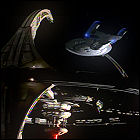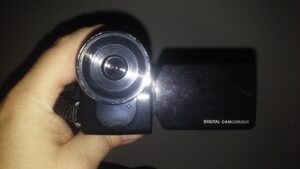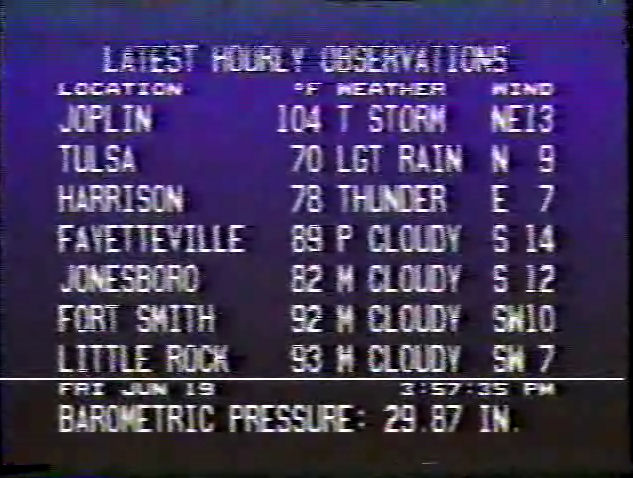 By the Prophets, has it really been 20 years? I remember it like it was yesterday – a contact of mine at a local TV station bringing me a fresh-off-the-satellite raw feed of the pilot episode of Star Trek: Deep Space Nine… just before New Year’s Eve, 1992. (Strange as it may sound, the episodes fed well in advance of the usually-over-the-weekend broadcast dates, to the tune of “at least a week”, so yes, I got to see the first episode of DS9 before 1993.) It was an awesome sight to behold. It was an intensely moving story, especially since I was 20 at the time and could relate to the sense of not-having-moved-on-from-something-really-bad-happening. It was a story that I needed to see; I suspect it was a story a lot of people needed to see. I was working in radio at the time (but was a few months away from transitioning to TV), so I was still a viewer (with inside info), although one of my last radio tasks was to interview Dennis McCarthy about the remixed version of the show’s theme. Deep Space Nine wasn’t my job yet.
By the Prophets, has it really been 20 years? I remember it like it was yesterday – a contact of mine at a local TV station bringing me a fresh-off-the-satellite raw feed of the pilot episode of Star Trek: Deep Space Nine… just before New Year’s Eve, 1992. (Strange as it may sound, the episodes fed well in advance of the usually-over-the-weekend broadcast dates, to the tune of “at least a week”, so yes, I got to see the first episode of DS9 before 1993.) It was an awesome sight to behold. It was an intensely moving story, especially since I was 20 at the time and could relate to the sense of not-having-moved-on-from-something-really-bad-happening. It was a story that I needed to see; I suspect it was a story a lot of people needed to see. I was working in radio at the time (but was a few months away from transitioning to TV), so I was still a viewer (with inside info), although one of my last radio tasks was to interview Dennis McCarthy about the remixed version of the show’s theme. Deep Space Nine wasn’t my job yet.
Warning: if you’re not up for reading a lot of stuff about Star Trek, the local end of broadcasting syndicated shows, and inter-office warfare, you probably don’t want to go past the jump.
This changed in the summer of 1997, when a bizarre and lengthy phone interview landed me a job in Green Bay, quite a move from Arkansas, where I’d worked in my home town my entire life. By that point, my “fan life” and my “professional life” had collided irrevocably: I was the promotions producer for a small mom-and-pop broadcasting company which ran a low-power Fox station and a low-power UPN station. As jazzed as I was to be working in TV, there were many times when these two stations looked like public access channels on cable, produced with leftover equipment (hint: we were, in fact, using leftover equipment). My greatest allies were a weather graphics computer that could do really clean chromakeying and an Amiga 4000 Video Toaster stack. I had figured out how to get these two wildly different things to work together even though they were from entirely different generations of technology.
 Some of the best work I’d done for the UPN side had been promoting Star Trek: Voyager. The first promotional hurdle to be jumped there was announcing that we were taking it from another local station (one at which, ironically, I would up working years later) which had aired the first season as a standalone syndicated show with no UPN affiliate in the market. When we signed on with UPN, that immediately cancelled the syndication contract, and we immediately found ourselves swimming upstream trying to promote the show’s change of venue. I went all-out on the Trek stuff, using everything from primitive homegrown CGI generated in Lightwave (we – well, I – was the only TV station production department doing in-house 3D at the time) to altering clips from the show by brute force to drop our station logo in over various viewscreens and monitors. I was in my element. I was often accused of putting more into the Trek promos than anything else because I was a fan. I’m not going to claim guilt or innocence there: I was doing my job. (I was also a huge Babylon 5 fan and would’ve gladly done the same for that show, except that our station manager had a huge chip on his shoulder about the fact that PTEN went from a Wild West documentary to something “useless” like Babylon 5. If I was able to sneak any B5 promotion into the rotation, it was usually a good indication that the skiing weather was great in hell for a day.)
Some of the best work I’d done for the UPN side had been promoting Star Trek: Voyager. The first promotional hurdle to be jumped there was announcing that we were taking it from another local station (one at which, ironically, I would up working years later) which had aired the first season as a standalone syndicated show with no UPN affiliate in the market. When we signed on with UPN, that immediately cancelled the syndication contract, and we immediately found ourselves swimming upstream trying to promote the show’s change of venue. I went all-out on the Trek stuff, using everything from primitive homegrown CGI generated in Lightwave (we – well, I – was the only TV station production department doing in-house 3D at the time) to altering clips from the show by brute force to drop our station logo in over various viewscreens and monitors. I was in my element. I was often accused of putting more into the Trek promos than anything else because I was a fan. I’m not going to claim guilt or innocence there: I was doing my job. (I was also a huge Babylon 5 fan and would’ve gladly done the same for that show, except that our station manager had a huge chip on his shoulder about the fact that PTEN went from a Wild West documentary to something “useless” like Babylon 5. If I was able to sneak any B5 promotion into the rotation, it was usually a good indication that the skiing weather was great in hell for a day.)
The awkward phone interview with my future employers in Green Bay covered a wide range of topics. What were our numbers like in Arkansas, and were my promos helping with those numbers? (Valid and very blunt question.) It sounded like I was a one-man production department, did I play well with others? Why did the first promo on my demo reel feature a live pig? (Because: the Arkansas Razorbacks, that’s why. Geez, Badger People.) And, after all that, basically, how soon can you move up here?
It’s important to note that I’d been breaking myself to the point of abject poverty sending out VHS demo reels for over a year at that point. This was before DVDs, and before online video. To send a resume and reel anywhere ran you about $4.50 per tape. I’d send them out in batches of ten or more, because I really wanted out of Fort Smith, and out of Arkansas if possible. I was being worked to the bone since my position as “production manager” was really a trap: “You have a title, so now you’re salaried! Work 14+ hours a day farting out crappy commercials!” I sent a tape to a station in Alaska. I wasn’t being picky. I got the Green Bay call on my 25th birthday, and let out a whoop after I’d hung up the phone. The sales guys came running to the production room from their offices, looking worried: they knew only one thing would make me that happy. Three weeks later, I was a resident of Wisconsin.
 One of the first things I got to do at the UPN station in Green Bay (shortly before putting my spare Morn figure on my desk as a good luck charm) was meet everyone and get the lay of the land, and one thing I quickly picked up on was that they had no ideas on pushing that station’s programming, and had no one dedicated to that task before I was hired. At the time, UPN was a Monday-through-Wednesday “netlet” (as Variety would put it), airing two hours in prime time those three nights. A movie was fed down to air over the weekend, along with a weekend repeat of that Wednesday’s Star Trek: Voyager. Looking at the schedule for the fall season that was about to begin, I quickly clued into one thing: these guys were completely missing the boat the sitting right in front of them. They had Voyager and its semi-high-concept cop show companion, The Sentinel, taking up Wednesday nights on UPN’s schedule. Hercules and Xena (known collectively in the syndication biz as the Universal Action Pack) were on Thursday nights. The last remnants of the PTEN syndication package (Babylon 5 and Kung Fu: The Legend Continues) were on Fridays. New Deep Space Nines aired on Sunday nights, along with the syndicated reruns of the revived Outer Limits and the TV series version of Poltergeist. DS9 ran in nightly “strip” syndication Monday through Friday at nine. The weekend Voyager rerun aired at 8pm on Saturday nights.
One of the first things I got to do at the UPN station in Green Bay (shortly before putting my spare Morn figure on my desk as a good luck charm) was meet everyone and get the lay of the land, and one thing I quickly picked up on was that they had no ideas on pushing that station’s programming, and had no one dedicated to that task before I was hired. At the time, UPN was a Monday-through-Wednesday “netlet” (as Variety would put it), airing two hours in prime time those three nights. A movie was fed down to air over the weekend, along with a weekend repeat of that Wednesday’s Star Trek: Voyager. Looking at the schedule for the fall season that was about to begin, I quickly clued into one thing: these guys were completely missing the boat the sitting right in front of them. They had Voyager and its semi-high-concept cop show companion, The Sentinel, taking up Wednesday nights on UPN’s schedule. Hercules and Xena (known collectively in the syndication biz as the Universal Action Pack) were on Thursday nights. The last remnants of the PTEN syndication package (Babylon 5 and Kung Fu: The Legend Continues) were on Fridays. New Deep Space Nines aired on Sunday nights, along with the syndicated reruns of the revived Outer Limits and the TV series version of Poltergeist. DS9 ran in nightly “strip” syndication Monday through Friday at nine. The weekend Voyager rerun aired at 8pm on Saturday nights.
How were they missing the fact that they had, at that point, more sci-fi on in prime time than Syfy does now?
 Thus was born the Invasion. I told them that I wanted to create a concerted, branded series of promos and interstitials (between-show pieces, i.e. “Xena is coming up… NEXT!”) to sew all this stuff together, because they actually had themselves a hell of a nifty schedule going; all I’d done was walk in there with a fresh set of eyes and said “Hey, you’ve got yourselves a hell of a nifty schedule going!”
Thus was born the Invasion. I told them that I wanted to create a concerted, branded series of promos and interstitials (between-show pieces, i.e. “Xena is coming up… NEXT!”) to sew all this stuff together, because they actually had themselves a hell of a nifty schedule going; all I’d done was walk in there with a fresh set of eyes and said “Hey, you’ve got yourselves a hell of a nifty schedule going!”
Once they saw what I was seeing, there was a meeting between the general manager, the program director, and that new 25-year-old promo guy who’d just arrived from Arkansas. The schedule was tweaked a bit further to account for the fact that new shows were about to be picked up at the last minute, and the PTEN shows would be evaporating right before the new season. Babylon 5 and Kung Fu would be replaced by the short-lived TV edition of Honey, I Shrunk The Kids and an earlier-in-the-week Friday night premiere of that week’s new first-run DS9. We were in business.
The spots, at first, looked like this. Very little time was really spent on coming up with the background, the logo, the graphics, or what have you – there was an NBC station in the same building with a rapidly growing news operation, so, you know, the art department wasn’t exactly going to blow a huge amount of time on the branding for this crazy never-gonna-work sci-fi block over on UPN that the new guy thought up. The phrase “it is what it is” came to mind, but at the same time – for the first time, I was in an environment where I could actually make a request of the art department instead of having to stop being the production department for half an hour to be the art department. That in itself was the height of luxury. Not having to do my own voice-overs was the height of luxury – those were farmed out to a local radio guy named Bill Lumay whose voice had actually fallen out of favor with station management because he was “too Hollywood movie trailer,” which is just what I needed. He wasn’t cheap, but man, did he sound great for what I wanted to do.
The sales department, of course, balked at the whole thing. Wait, are we saying that the UPN station is the Sci-Fi Channel now? (No, was my amused-yet-exasperated reply, as long as we’re still showing the PTEN stuff on Fridays, we’re Sci-Fu.)
I started work the first week of August 1997. I proposed the UPN 32 Prime Time Invasion about a month into my new gig, and we spent late September and October sharpening the look and ironing out the kinks. November sweeps was coming up. One of three things would happen:
- I would be completely vindicated as having come up with a good idea.
- The Invasion would fall flat, the interstitials and the thunderous voice-overs and logos would quietly disappear, and the station would go back to being promoted as a “normal” local TV station as the new guy got his wings clipped.
- It’d tank disastrously and I’d be thumbing a ride back to Arkansas.
When the Nielsen ratings books arrived shortly before Christmas 1997, would you believe that the answer was #1? It was a solid hit out of the ball park. We had just become one of the ten fastest-growing UPN stations in the country. I don’t remember what, if anything, I got for Christmas that year. That did me just fine right there. A hint that maybe, just maybe, I was as good as my resume claimed I was, and that I was worth hauling out of the deep south and transplanting to a larger market, and that my nutty idea of stealing the Sci-Fi Channel’s mojo was actually viable.
 In 2008, the Invasion got a makeover; I got to use an Avid Media Composer for the first time, allowing me to cook up and import my own graphics. I went nuts and did multi-layered animated starfields. (It was no skin off the overworked art department’s back that I felt like doing my own thing.) More to the point, it was clearly felt that the concept was worth lavishing time and attention on.
In 2008, the Invasion got a makeover; I got to use an Avid Media Composer for the first time, allowing me to cook up and import my own graphics. I went nuts and did multi-layered animated starfields. (It was no skin off the overworked art department’s back that I felt like doing my own thing.) More to the point, it was clearly felt that the concept was worth lavishing time and attention on.
I will say that there was often a feeling during this period that Deep Space Nine was the poor relation of the two Treks (despite the fact that I was still consistently enjoying it a lot more than Voyager). It popped a decent number, indicating a loyal audience, but when UPN expanded to five nights in late 1998, DS9 was the first thing to get bumped (back to Sunday nights only). It was also general knowledge by this time that we were about to ditch DS9 in nightly strip syndication; Voyager would be available in strip in 1999, and it was a no-brainer as to what would be taking DS9’s place. Furthermore, the DS9 strip gradually slipped later and later into the late-night hours, fighting a losing battle against the ten o’ clock newscasts. There was a sense that the station management (and sales) were simply waiting for the show to make its exit, and the sooner the better.
For the show’s extended-length grand finale in 1999, taking up ten weeks of episodes to tie off all the storylines, I was determined to see DS9 off in style. For one thing, the Star Wars Episode I trailer had just premiered, and I cranked out a fairly epic one-minute promo which shamelessly stole that trailer’s gag. (To contrast: these days, promos are seldom even 30 seconds in length; one minute is lunacy.) (One rather dull afternoon, the front desk put a call through to me from a fan who wanted to know when that promo was going to air again.)
And as the end of the show approached, Paramount generously put an offer out there for any stations wanting to construct a contest around DS9 – they’d pony up for tickets to Star Trek: The Experience (guys, really! big spenders!). I came up with an exceedingly simple “watch the episode for the secret phrase, write it on a postcard and send it in” contest, the entries from which we’d randomly draw our winner. There was actually vigorous protest from the sales department about blowing contest time on Deep Space Nine; they had the Seinfeld finale to worry about on the NBC sister station!
 The promo was my one last epic Trek geek-out – it didn’t get much geekier than Okudagrams as on-air graphics! – but sales threw one final tantrum and yanked any support from the contest. The contest proceeded anyway, with the airfare for the lucky party of four coming from the promotions department budget instead.
The promo was my one last epic Trek geek-out – it didn’t get much geekier than Okudagrams as on-air graphics! – but sales threw one final tantrum and yanked any support from the contest. The contest proceeded anyway, with the airfare for the lucky party of four coming from the promotions department budget instead.
More people entered that contest than any non-children’s-programming-related contest the station had ever held up to that point. Proof, of course, that nobody watches Deep Space Nine.
The promo items from Paramount were surprisingly elaborate. The final season’s promo kit was a gigantic pie-wedge-shaped box that opened up to show the wormhole; the actual promo material was in a folder that just melted seamlessly into that box.


The pie wedge, when stood upright like this, was over two feet tall. But that didn’t hold a candle to this baby, which was mailed out to the stations at what had to be great expense not long before the last ten-episode stretch of new material:

It was made of pewter and glass and it was beautiful. Sadly, I sold it about a year ago on eBay – me being out of a job overrode my desire to hang on to my trove of TV promo goodies. I’ll say only that it went for a pretty decent price, and helped to pay quite a few bills for a while. Deep Space Nine to the rescue again.
I really loved that my fandom of this show, and a select few others, became how I made my living for a while. Voyager was a different beast; its promos, and promo strategy (and indeed the notes heaped onto its long-suffering producers and writers) came from UPN, which always seemed to operate on the basis of “This show is incredibly geeky, but we’re going to try to sex it up so normal people will watch it!” The DS9 (and, before it, TNG) promos came from Paramount Domestic Syndication, whose promotions were handled by Gary Holland, a guy so talented that he actually co-wrote two episodes of DS9 himself (The Collaborator and Children Of Time). As wowed as I was by having an art department and outside voice talent at my disposal, my previous small-town TV gig hadn’t prepared me for the hitherto unthinkable notion of calling a show’s promo department to request stuff. Whether we were missing promo material, or needed stuff for a contest, or needed a clean copy of the show logo to use in a promo, he and his staff were beyond helpful in making sure we got what we needed.
So there you have it – a show that was as much fun to “work” as it was to just sit and watch (I happily did both). I had no impact on DS9 outside of trying to convince everyone in Green Bay to watch it (and our other shows), even to the point of openly poking fun at the sports programming whose viewers were surely openly snickering at the idea of watching Star Trek instead (a slightly ballsy stance to take in Green Bay). I can claim no impact on more than a local level. And yet I remember looking at the Nielsen books and getting a chuckle out of how much of a fight I was putting up to promote a venue for alternative-to-the-mainstream programming in a sports-heavy market… because I could see from the ratings that someone was taking me up on the invitation*.
There’s an archive of my old Star Trek spots here, as part of a much larger archive of my TV promo work in general. Some of it’s really old, and so funky as to be laughable by modern standards – I was young, and got away with a lot, including some really questionable readings of what was permissible for on-air promos. As you do. My job was a blast way back in the 20th century, and I’d do it all again.
* on everything but Team Knight Rider, though that wasn’t for lack of trying on my part. Who even remembers that show now?



+ There are no comments
Add yours